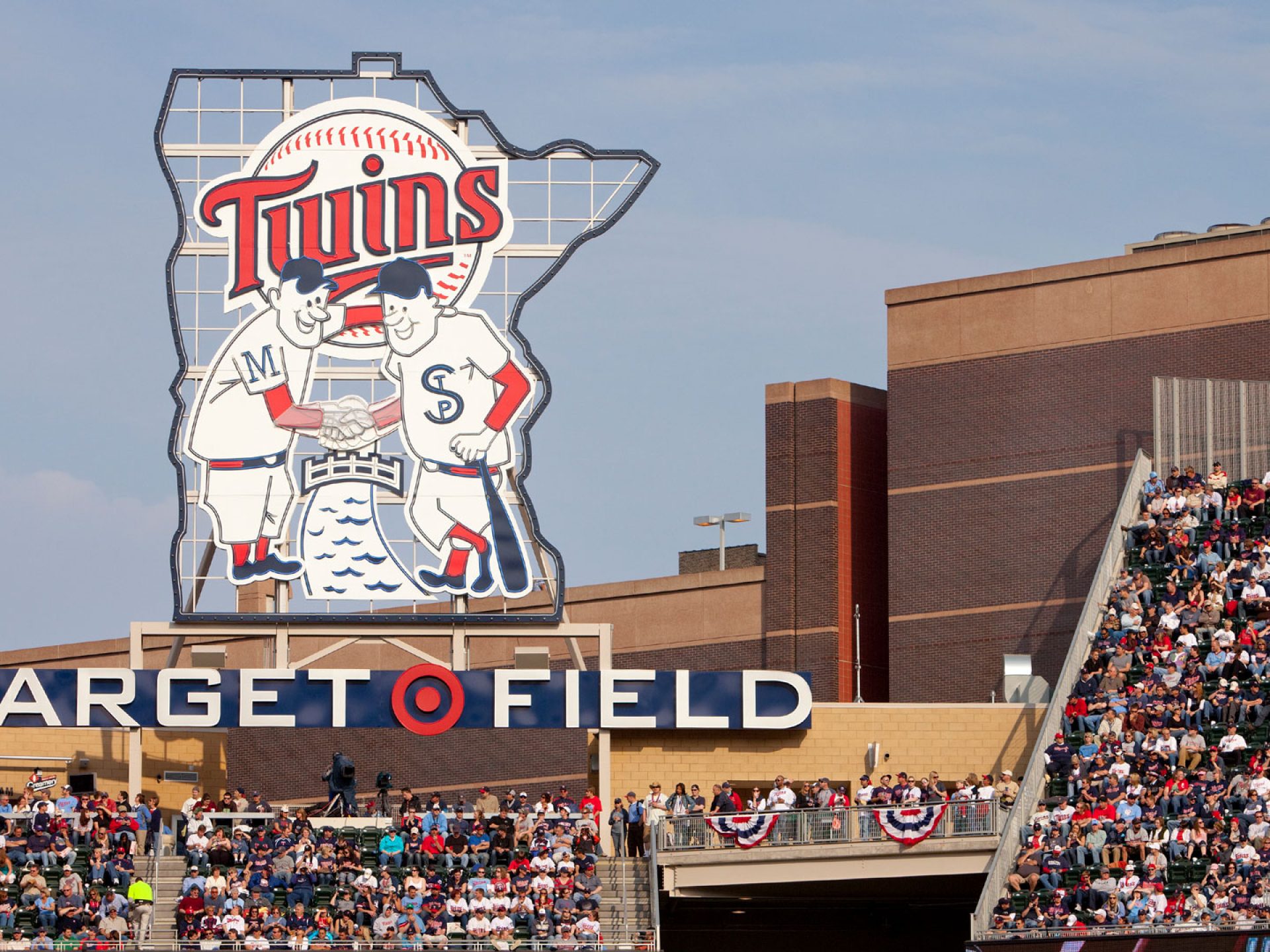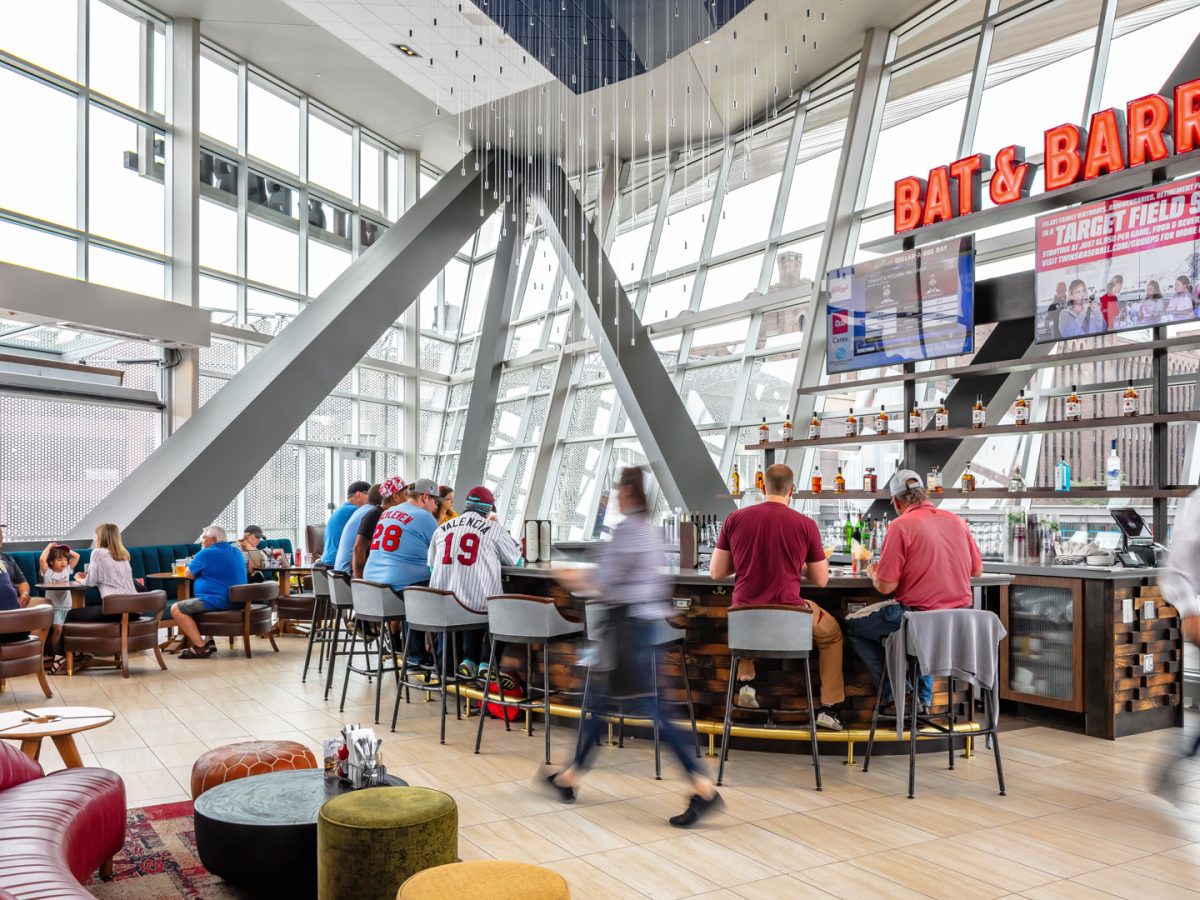March 28, 2019
Allianz Field Continues the Tradition of Beloved Twin City Sports Homes

Minnesota sports fans not only love their teams, they also love their home venues. Starting with Xcel Energy Center in 2000, the Twin Cities have been thriving and opening facilities that hold a special place in the hearts of locals and tourists alike. Opened in April, Allianz Field has not only become the latest in that long string of success, but it’s also the latest Twin City icon to be designed by Populous.
One thing we’ve learned over the last two decades of working with our Northern friends is how much they prioritize good design. It’s one of the reasons we’re grateful to be invited back time and time again.
Building credibility in the North Star state’s biggest community didn’t come easy. It took time and energy to develop a sensibility for what matters most to those who live there. Before we examine how Allianz Field carries on in that tradition, let’s take a look back at the places drawing Minnesotans together for the past 20 years.
NHL expansion was booming in the 1990s – and the only way for Saint Paul to get in on the action was to first build a new multipurpose arena. After several failed funding attempts, the project was eventually funded by the state of Minnesota in April of 1998. Together with Twin City stakeholders, Populous designers worked their magic and designed the state-of-the-art facility that opened at the turn of the millennium. Four short years later, ESPN declared Xcel Energy Center the best overall sports venue in the United States. Most importantly, it’s a fantastic place to watch hockey.
After hockey, Populous turned its focus toward bringing football back to the University of Minnesota’s Twin City campus with the debut of TCF Bank Stadium in 2009. A year later, the Minnesota Twins’ Target Field opened. The SportsBusiness Journal’s 2011 Facility of the Year, Target Field lives in the North Loop of downtown Minneapolis and sits on one of the tightest urban sites in Major League Baseball. This walk down memory lane brings up a few vital themes that make all of these facilities – including Allianz Field – special:
- A focus on improving the fan experience through design and hospitality
- A focus on creating sustainable, authentic community assets
- A focus on community and amplifying the local culture
Let’s dive a bit deeper into each of these themes and how they’re reflected through our Twin Cities projects:
A focus on improving the fan experience through design and hospitality
The Minnesota community is design-oriented and design-conscious. They own their cosmopolitan culture and take pride in a thriving craft beer and culinary scene, all important factors in strong premium hospitality spaces.
At Target Field, we unveiled new award-winning premium club renovations last year. Bat & Barrel, the Minnesota Twins’ new club, was designed as an open, social gathering space to immerse fans in Twins history. Replacing the former Metropolitan Club, Bat & Barrel is open to all fans and features large field-facing operable glass walls, an infield-shaped bar, Minnesota-based original artwork. In addition to other prominent awards won by Twins players, the 1987 and 1991 World Series trophies call the space home as well.
“During the season, you’d see plenty of folks moving in and out of the space, many for an inning or three. It certainly was a hot spot and attracted a prime sports-going demographic: millennials who don’t spend nine innings glued to their seats,” said Kevin Reichard of Ballpark Digest.
Allianz Field’s Brew Hall is another example of the Twin Cities’ craft beer and outdoor culture reflected through design. The Brew Hall offers a pub-like atmosphere open to all ticket holders. On top of the Brew Hall, a roof deck allows for fans to enjoy the sunshine on beautiful Saint Paul days.
Offering a variety of experiences is the key to fans coming back again and again. It encourages exploration. If after one visit to a venue you feel like you’ve seen it all, then we’ve missed the mark as designers. Our venues are best experienced over time. Lucky for us, Minnesotans love exploring. It’s this spirit of adventure that we have in mind when incorporating authentic and sustainable features into our Twin City projects.
A focus on creating sustainable, authentic community assets
Placemaking and sustainability are vital in any design project, which is why we make every attempt to bring elements of each project’s community and culture inside the venue. With the Xcel Energy Center, we used the theme of “homegrown hockey” to drive the design. The concourse areas display a jersey from every high school in Minnesota hanging on the wall, reflecting the “State of Hockey.”
With Target Field, we used a similar approach with the materials on the exterior. Native limestone, sourced from nearby Mankato, is used on the exterior and offers a striking appearance. These materials were extracted and manufactured within 500 miles of the ballpark to limit the negative environmental impacts of transporting them.
Allianz Field’s exterior, on the other hand, captures the energy of the Northern Lights with an LED skin. This skin was based on the flow of water and the night sky. Using a laminated PTFE mesh, the LED skin material is reflective and translucent, like water, and mesmerizes passers-by day and night.
Ultimately, being authentic to the Twin Cities by using local materials results in greener, more sustainable buildings. While Xcel Energy Center, TCF Bank Stadium and Target Field are all impressively LEED certified, Allianz Field is re-setting the sustainability bar with a unique approach. Debuting as the most bird-friendly venue in the MLS, the PTFE exterior is not only beautiful, it’s “bird safe” based on its lack of reflectivity and transparency. Innovative stormwater management was designed into the stadium and surrounding development as well.
A focus on community and amplifying local culture
In addition to having a foodie and craft beer culture, the Twin Cities are known for their active lifestyle. To support that culture, it was vital that each venue supported year-round activity and was accessible to mass transit.
The most urban ballpark in Major League Baseball, Target Field maximizes its setting with pedestrian bridges that connect the ballpark to the city. Its urban appeal is enhanced with the creation of the acclaimed Target Plaza, the ballpark’s ‘public garden’ beckoning Minnesotans to the site year-round. Enhancements to Target Plaza debuted Opening Day 2019 and further enliven the ballpark’s main entry.
In contrast, TCF Bank Stadium was designed in a way that offered a visual connection to the city rather than a physical one. We laid the stadium out on the site in an unorthodox east-west configuration, with the open west end of the stadium facing campus. This layout was strategic and gives the fans a visual connection to downtown Minneapolis.
Additionally, Target Field has been hailed as the most multimodal ballpark in America. What does that mean? It means the design provides the most and best access to arrive to the ballpark through public transportation. From light rail transit to buses and even being located on the Cedar Lake Bike Trail, Target Field is convenient for fans arriving on four wheels, two wheels or by foot.
Similarly, Allianz Field is also connected to its urban surroundings. Its central location brings the Twin Cities together. On the north side of the stadium sits the 28,000-square-foot “Great Lawn.” The Great Lawn can be host to numerous activities like concerts, festivals and more and is just one more place for Minnesotans to live their active outdoor lifestyle year-round.
At the end of the day, while the Twin Cities embody these three principles, they can be seen in other locales. They’re important to all projects because they focus on the community and the fan experience. If the client and design team prioritize the fan experience in the design process above all else, it will ultimately result in an authentic venue that is beloved by fans.
Lorem ipsum dolor sit amet consectetur, adipisicing elit. Non facere corporis et expedita sit nam amet aut necessitatibus at dolore enim quis impedit eius libero, harum tempore laboriosam dolor cumque.
Lorem, ipsum dolor sit amet consectetur adipisicing elit. Illo temporibus vero veritatis eveniet, placeat dolorem sunt at provident tenetur omnis, dicta exercitationem. Expedita quod aspernatur molestias eum? Totam, incidunt quos.




